Updated Jan. 18
Collective Hug’ Over Bryan Monroe:
Funeral Tuesday, Scholarship Established
NBCUniversal to Spend $6.5 Million on Colleges
Janice Johnston Named EP of ABC’s ’20/20′
Black Photographer to Record Harris’ Tenure
Media Want Transparency on Potential Violence
Media Ramp Up Coverage of White Supremacy
When Media Again Helped Foment a White Riot
Short Takes
Support Journal-ismsFuneral Tuesday, Scholarship Established
There was the time Bryan Monroe became part of a delegation that met secretly with the musical icon Prince before what would be one of his last public appearances. That was at the National Association of Black Journalists convention in Minneapolis in 2015.
But there was also a remembrance of when Monroe, then obese, fell into a diabetic coma after a 2004 meeting in Washington of the American Society of Newspaper Editors. Colleagues rushed him to the hospital, where Monroe was warned that if he didn’t lose weight, he wouldn’t see his kids grow up.
Those were just two of the remembrances that surfaced during a nearly two-hour Zoom call described as a “collective hug” by Dorothy Tucker, NABJ president, and “therapeutic” by Jerry Ceppos, a veteran journalist who worked with Monroe at the San Jose Mercury News and helped rush him to the hospital that day in 2004.
Monroe, a journalism professor and former NABJ president who shared in a Pulitzer Prize, died Wednesday at his suburban Washington home after a heart attack. He was 55. Forty-two of his NABJ colleagues, including seven former NABJ presidents, were on the Zoom. So were colleagues from CNN Digital, where he had been op-ed editor and editor of CNNPolitics; Johnson Publishing, where he was vice president and editorial director at Ebony and Jet magazines, and Temple University, where he was Verizon chair and professor at the Klein College of Media and Communication.
Tucker announced that funeral services would be held Tuesday at 11 a.m. Eastern, with details to come, and to be followed by a memorial service “a few weeks later.”
The family announced Sunday night that “Due to current pandemic environments, only the immediate family will be in physical attendance. The Family invites and encourages everyone to join us via a virtual live stream beginning at 10:45am EST. We ask that you connect using: https://www.haripclosefunerals.com/services/ then click on Live Stream. The password is ‘Monroe’.”
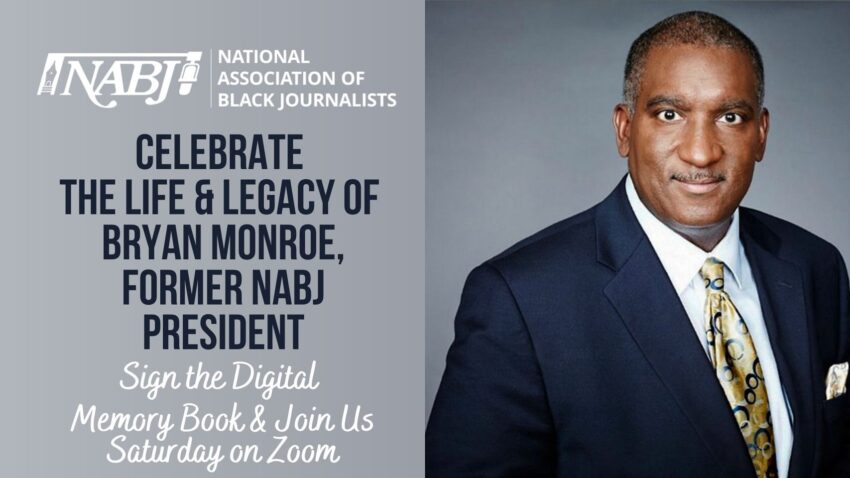
David Boardman, dean of the Lew Klein College and who hired Monroe to teach there, announced that the family is establishing a scholarship there in Monroe’s name.
The NABJ call was recorded and may be viewed here. It was organized by Tucker and Herbert Lowe, who immediately preceded Monroe as NABJ president and wrote his own tribute at The Undefeated.
Lowe had organized another Zoom call where, Lowe wrote, “Two dozen of us the night he died spent nearly three hours remembering Bryan. . . . It was incredibly joyous and heartbreaking, loving and cathartic, emotional and resolving for us to recall his friendship, spirit, encouragement, generosity, confidence, leadership, vision, hugs, love for his family – and, yes, his willingness to pick up the check for expensive meals and alcohol.”
Saturday’s call had many of the same qualities.
“He would hold court and tell such great stories,” said Meredith Artley, who as senior vice president and editor in chief at CNN Digital worldwide was Monroe’s boss at that network. “He had this general charisma that was so powerful. He was always talking about connecting the dots. He was the guy who everyone wanted to be around.”
Akili Ramsess, executive director of the National Press Photographers Association, recalled how Monroe, the “happy warrior,” recruited her to chair NABJ’s Visual Task Force. “He would see something in you and pull it out,” taking you “to levels you didn’t even imagine for yourself.”
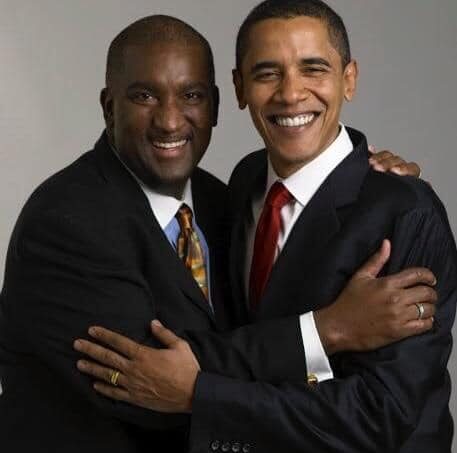
Herbert Lowe wrote of Bryan Monroe’s tenure at Johnson Publishing Co., “his greatest contribution was getting Ebony and Jet ready for the Obama moment.” (Credit: Renee Ferguson/Facebook)
Errol Cockfield, a former Newsday journalist and NABJ regional director who is now senior vice president, communications at MSNBC and NBC News, told the group, “He gave me a sense of what’s possible for a Black person. I saw in him how to be a leader. He was comfortable in his own skin as a Black man.”
Sonya Ross, longtime Associated Press reporter now editor in chief at Black Women Unmuted, recalled challenging Monroe’s decision at Ebony to advocate “burying” the n-word.
How can you get rid of a word? Ross asked. Their debate continued for years, she said. “I’m a litttle bit sad that we won’t be able to debate the merits and demerits of this epithet” any longer, Ross concluded.
Sarah Glover, immediate past NABJ president and, like Monroe, a photographer, said, “His footprint was beyond the two years he served as president,” 2005-2007, a time when she was the board secretary. “He’s been shaping the lives and careers of so many of us.”
Syb Brown, a professor of journalism at Belmont University in Nashville known as “Dr. Syb,” told the story of Monroe’s enviable luck in securing access to the meeting with Prince at the Minneapolis convention. She called Monroe “the person with the big enough shoulders. Sometimes God makes us big for a reason.”
Two other association presidents were present, Mira Lowe of Journalism & Women Symposium (JAWS), who under Monroe became the first female editor of Jet, and Sharif Durhams of the National Lesbian and Gay Journalists Association, known as “NLGJA: The Association of LGBTQ Journalists.” Dunham and Monroe served together as judges in the National Headliner Awards.
In addition to Tucker, Lowe and Glover, NABJ presidents on the call were Bob Butler, Gregory H. Lee Jr., Kathy Times, Will Sutton and Arthur Fennell.
Butler spoke for many when he concluded his remarks with, “I’m glad to see my family.”
- Colin Evans and Madison Karas, Temple News, Temple University: Remembering Bryan Monroe, journalism professor and icon
- Annie Sciacca, Bay Area News Group: Bryan Monroe, journalism industry leader and former Mercury News deputy managing editor, dies at 55
- Joseph Serwach, medium.com: Bryan Monroe was a Bridge Between Old Newspapers and the New Digital Journalism
- Susan Snyder and Valerie Russ, Philadelphia Inquirer: Temple University professor and media icon Bryan Monroe dies suddenly at 55
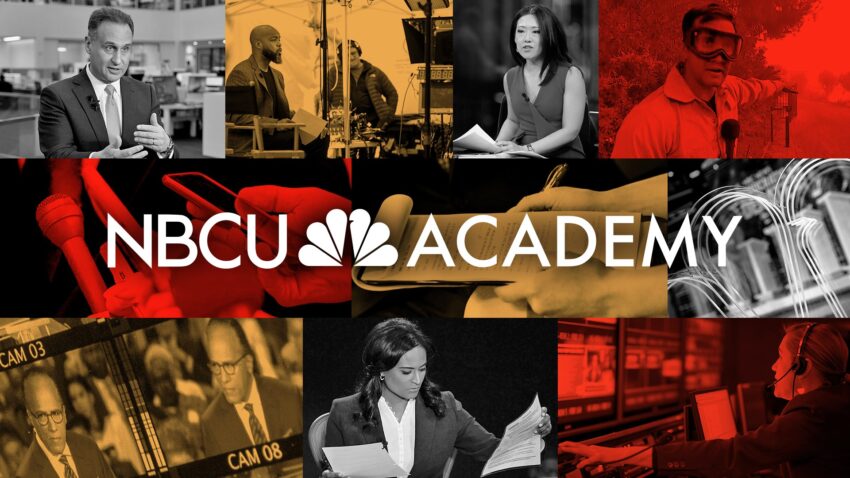
NBCUniversal to Spend $6.5 Million on Colleges
“In a push to bring journalism education to underrepresented groups, NBCUniversal is partnering with 17 historically Black colleges and universities, Hispanic-serving institutions and colleges with significant Latino, Asian, Black, Indigenous and tribal populations with NBCU Academy,” Sakshi Venkatraman reported Thursday for NBC News.
“The program promises to offer students from a wide array of racial and economic backgrounds on-campus training, online programs, scholarships and chances for interaction with NBC News reporters.
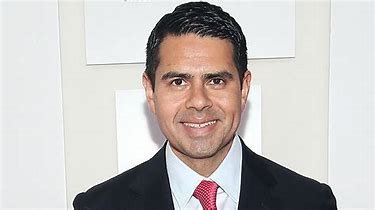 “NBCUniversal is dedicating $6.5 million to the initiative, including scholarships this year worth $250,000, including $3.5 million in scholarships, the company said.”
“NBCUniversal is dedicating $6.5 million to the initiative, including scholarships this year worth $250,000, including $3.5 million in scholarships, the company said.”
The participating institutions are: Borough of Manhattan Community College in New York; California State University, Fullerton; Claflin University, Orangeburg, S.C.; Clark Atlanta University; Dallas College in Texas; El Camino College, Torrance, Calif.; Florida International University, Miami; Hampton University in Virginia; Institute of American Indian Arts in Santa Fe, N.M.
Also, Miami Dade College in Florida; Morgan State University in Baltimore; North Carolina A&T State University in Greensboro; Orangeburg-Calhoun Technical College in Orangeburg, S.C.; City College of New York; University of North Texas in Denton; University of Texas at El Paso; and Xavier University of Louisiana in New Orleans.
“The NBCU Academy is a ‘put-your-money-where-your-mouth-is’ commitment to newsroom diversity,” said DeWayne Wickham, dean of the School of Global Journalism and Communication at Morgan State, which is receiving $500,000.
“It is a partnership of substance that strengthens our faculty and enhances the ability of our students to enter the journalism profession heavily armed with the skills they need to succeed.”
Robert Martin (Cherokee), president of the Institute of American Indian Arts, said, “We welcome this opportunity to partner with NBCU Academy to increase Indigenous storytelling in mainstream journalism. Storytelling is an integral part of Indigenous communities but is often missing in media or clichéd when told by non-Indigenous journalists. This collaboration will benefit IAIA students by providing access to scholarships, internships, equipment, courses, and NBC mentors with real-word experience in the field.”
NBCU News Group chairman Cesar Conde (pictured above), said, “Creating an inclusive culture for journalism that represents the communities we serve is at the very core of what we do.”
Conde, previously chairman of NBCUniversal Telemundo Enterprises, was moved atop the entire news division in a broader NBCU management shakeup in May. In July, he set a goal of having a 50 percent diverse work force across his division and “announced a multi-year $100 million commitment to help address systemic racism and inequality,” a news release said. “NBCU Academy is part of that pledge. . . .”
- Jeff Amy, Associated Press: Apple, utility each give $25M to Black college learning hub
Janice Johnston Named EP of ABC’s ’20/20′
 Janice Johnston (pictured) has been promoted to executive producer for “20/20,” the network’s chief newsmagazine, ABC News President James Goldston announced on Thursday. Johnston is the first woman and the first African American in the job.
Janice Johnston (pictured) has been promoted to executive producer for “20/20,” the network’s chief newsmagazine, ABC News President James Goldston announced on Thursday. Johnston is the first woman and the first African American in the job.
“It’s not often we have the opportunity to announce a new EP for 20/20. Janice is only the fourth person to lead this fantastic team in nearly 43 years,” Goldston wrote to the staff. “She is a terrific journalist with an impressive talent for telling stories that resonate and an exceptional leader.
“As a senior producer for 20/20, she’s been at the helm of critical programming in the last year, including our two-hour broadcast on Vanessa Guillen and three breaking news specials on the COVID-19 pandemic. Janice also led two-hour 20/20 events on John Lennon’s life, legacy and last days, the Yosemite Serial Killer and Robin Roberts’ interviews with three women kidnapped and held captive in Cleveland for a decade.
“In [a] brilliant 22-year career at ABC News, Janice has seniored, produced and directed dozens of primetime specials, including our Emmy-winning town hall The President and The People, Highwire Over Niagara Falls: LIVE, the CMA Awards In the Spotlight series, and entertainment documentaries on Dolly Parton, Bobby Brown, Luke Bryan and more. She’s overseen productions on location all over the world, from Hawaiian volcanoes and Mount Kenya to Taylor Swift’s house and the White House. . . .”
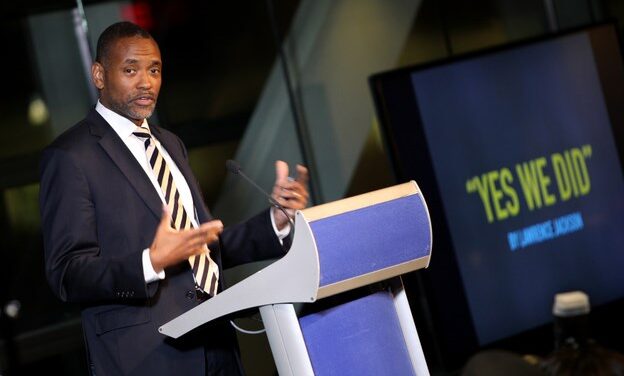
Black Photographer to Record Harris’ Tenure
Lawrence Jackson, the only African American photographer in the Barack Obama White House, has been chosen as Vice President-elect Kamala Harris’ official photographer, Alex Weprin reported Friday for the Hollywood Reporter.
He will thus have documented the tenure of the first African American president and the first African American and Asian American vice president.
Jackson produced a book of his White House photographs, “Yes We Did,” in 2019. Obama wrote the foreword, saying that as Black men, the two had much in common.
“He and I had similar upbringings as black men in America, each of us raised by an extraordinary single mom, both of us knowing what it’s like, at times, to feel as if we might not belong. Many of his photos are informed by that sensibility . . . “
Since the Obama years, Jackson has freelanced, including stints as campaign photographers for Pete Buttigieg and Elizabeth Warren. He told Journal-isms by telephone Monday that he was instructed not to talk with the news media without permission.
“TJ Ducklo, who had been press secretary for the campaign, will be the deputy press secretary in the White House; former Obama White House communications director Jen Psaki will be press secretary,” Weprin wrote. “Ducklo joined the campaign from MSNBC, where he worked in its press shop.”
“Adam Schultz will be the chief official White House photographer, after serving as the campaign’s official photographer. Drew Heskett will be the presidential videographer. . . .”
Jackson was a staff photographer for the Associated Press in Boston and Washington from 2000 to 2009, and worked at the Virginian-Pilot in Norfolk from 1991 to 2000. He is also the son-in-law of Sen. Patrick Leahy, D-Vt.
“I’m a D.C. based photographer who covers news, events, editorial, portrait and lifestyle photography,” Jackson wrote on his website.
“My career has taken me from the small town fairs of rural Virginia to meetings in the Oval Office of the White House and beyond. I love that photography has the power to inform, inspire and evoke emotion — sometimes all three things happen in one picture.”
Meanwhile, it remained unclear whether Biden would follow recent Democratic presidents and designate communications people to assure access for media and journalists of color — called “specialty media.” Under Obama, Shin Inouye, director of specialty media, also managed media relations with veterans, LGBT people and youth.
Ramzey L. Smith, African American media director at Biden for President, was not responsive when asked what the Biden administration planned.
Pro-Trump rioters broke Associated Press television equipment on Wednesday outside the Capitol.
?Credit: Jose Luis Magana/Associated Press pic.twitter.com/opLwGp5UBO
— Veronica Waters (@MissVWaters) January 11, 2021
Media Want Transparency on Potential Violence
“A coalition of news organizations today sent a letter to federal law enforcement agencies calling for greater transparency and timely, vital information about the January 6 attack on the U.S. Capitol Building and the possibility of further violence, including at the upcoming inauguration of President-elect Joe Biden and Vice President-elect Kamala Harris,” the National Association of Broadcasters announced on Thursday.
” ‘The agencies must share information about possible civil unrest in the days leading up to Inauguration Day, January 20, through frequent and regular in-person press briefings so the public and news outlets can be properly informed about viable threats and can take appropriate action to protect themselves,’ states the letter. . . .
“Signing the letter were the National Association of Broadcasters, Asian American Journalists Association, National Association of Black-Owned Broadcasters, National Association of Hispanic Journalists, National Newspaper Association, Native American Journalists Association, News Media Alliance, News Media for Open Government, News Leaders Association, Online News Association, Radio Television Digital News Association, Reporters Committee for Freedom of the Press and Society of Professional Journalists.”
Kanya Stewart, spokesperson for the National Association of Black Journalists, messaged Sunday, “We checked and do not recall or see that we we received notice of this collaboration before it was published. It is, however, something that NABJ would have signed on to. We plan to reach out to see who might have been the organizer to find out more about it. I am sure we were just inadvertently missed in requesting our signature.”
- John Eggerton, Broadcasting and Cable: NAB’s Gordon Smith Urges Journalist Briefings on Potential Inauguration-Related Violence
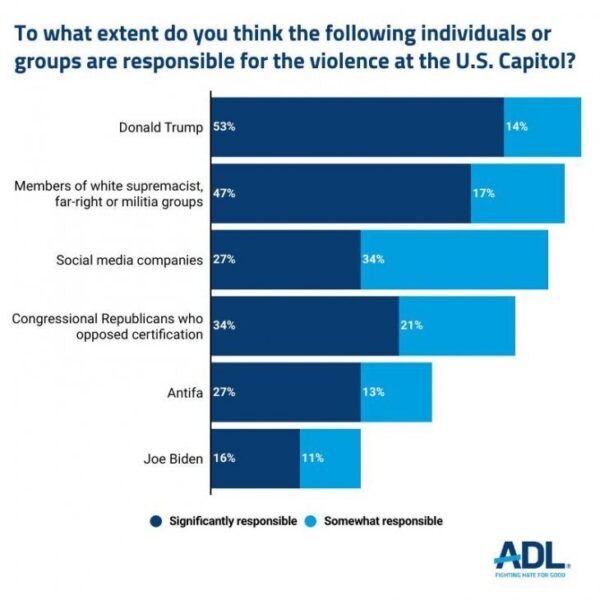
Media Ramp Up Coverage of White Supremacy
“What happened on Wednesday at the Capitol was about preserving whiteness. That’s what this is about. This is the tough conversation that we must have. And preserving it in the worst possible way, which is white supremacy.”
That was CNN’s Don Lemon speaking in the aftermath of the Jan. 6 insurrection in Washington.
Lemon received blowback, of course, but his was only one discussion in a media in which white supremacy became a major topic last week. White supremacy in the military. In law enforcement. In the Capitol. Hillary Rodham Clinton wrote an op-ed in The Washington Post under the headline, “Trump should be impeached. But that alone won’t remove white supremacy from America.”
In The New York Times, veteran Washington journalist Thomas B. Edsall delved more deeply into the white American psyche with “a wide range of experts.”
“There is no question that out-and-out racism and a longing to return to the days of white supremacy were high on the list of motivations of the pro-Trump mob that ransacked the Capitol on Jan. 6,” Edsall wrote Wednesday.
“It may sound trivial at first, in light of what happened, but how important is the frustration among what pollsters call non-college white men at not being able to compete with those higher up on the socioeconomic ladder because of educational disadvantage? How critical is declining value in marriage — or mating — markets? Does any of that really matter?
“How toxic is the combination of pessimism and anger that stems from a deterioration in standing and authority? What might engender existential despair, this sense of irretrievable loss? How hard is it for any group, whether it is racial, political or ethnic, to come to terms with losing power and status? What encourages desperate behavior and a willingness to believe a pack of lies?
“I posed these questions to a wide range of experts. This column explores their replies. . . .”
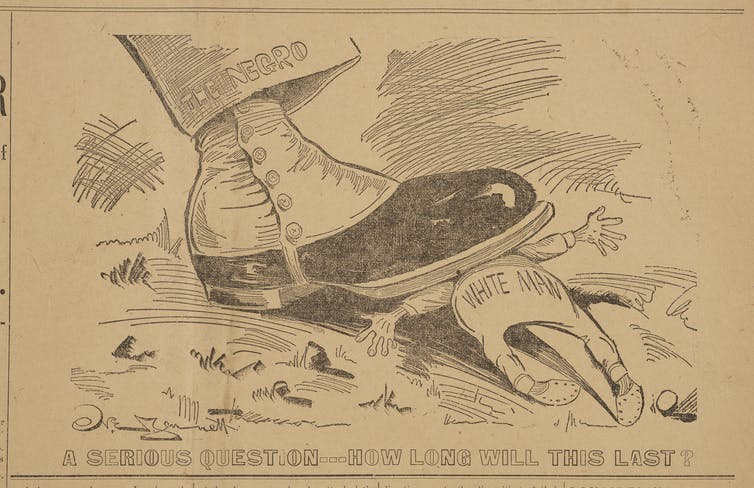
When Media Again Helped Foment a White Riot
“While experts debate whether the U.S. Capitol siege was an attempted coup, there is no debate that what happened in 1898 in Wilmington, North Carolina, was a coup – and its consequences were tragic,” journalism professors Kathy Roberts Forde of the University of Massachusetts, Amherst and
Kristin Gustafson of the University of Washington, Bothell, wrote Friday for The Conversation.
“These two events, separated by 122 years, share critical features. Each was organized and planned. Each was an effort to steal an election and disfranchise voters. Each was animated by white racist fears.
“And each required the help of the media to be successful. . . .”
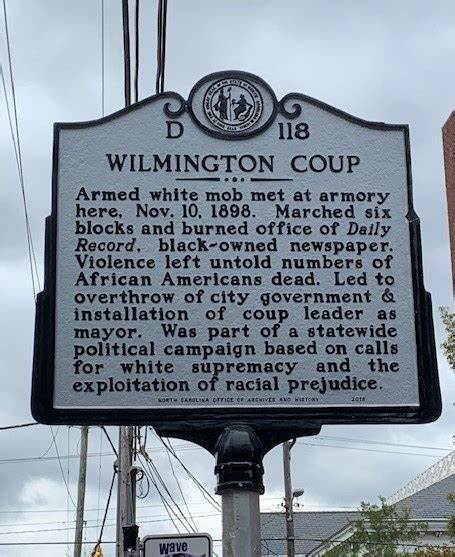
Last week in this space (scroll down), this column reported that “in reaching for analogies to the insurrection at the U.S. Capitol on Wednesday, MSNBC host Chris Hayes recalled the riot that took place in 1898 in Wilmington, N.C., in which a white coup d’etat replaced the city’s duly elected officeholders with white supremacists.” LeRae Umfleet, a state researcher who wrote a 600-page report on the events, cited The Washington Post in discussing out-of-state reporters who played a role in inciting the violence.
We asked whether a mea culpa from the Post was in order.
However, it was not just the Post, two authors who have written about the Wilmington riot tell Journal-isms.
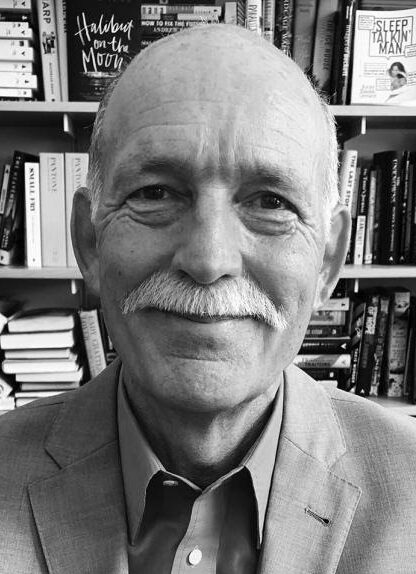 Pulitzer Prize-winning reporter David Zucchino (pictured), who wrote “Wilmington’s Lie: The Murderous Coup of 1898 and the Rise of White Supremacy,” messaged, “Yes, the Washington Post and virtually every other major northern newspaper — and several southern newspapers such as those in Atlanta, Richmond and Charlotte — sent white reporters to Wilmington in anticipation of a promised coup.
Pulitzer Prize-winning reporter David Zucchino (pictured), who wrote “Wilmington’s Lie: The Murderous Coup of 1898 and the Rise of White Supremacy,” messaged, “Yes, the Washington Post and virtually every other major northern newspaper — and several southern newspapers such as those in Atlanta, Richmond and Charlotte — sent white reporters to Wilmington in anticipation of a promised coup.
“They ’embedded’ with white supremacist vigilantes and repeated the white supremacist narrative that Black citizens were planning to rise up, murder white men and rape white women. That’s the story northern readers got, thanks to an uncritical and deeply biased northern press.”
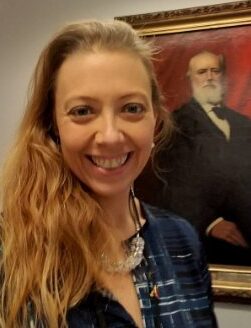 Umfleet (pictured) turned her research into a book, “A Day of Blood: The 1898 Wilmington Race Riot.” She elaborated to Journal-isms, “At the time of the violence in Wilmington in November 1898, newspapers were THE source of information for news across the country, and, therefore, wielded much influence. Lacking television, radio, and the internet, the only way to get news was the newspaper, and segments of the population subscribed to papers from across the spectrum to learn the day’s/week’s news locally, statewide, and nationally.
Umfleet (pictured) turned her research into a book, “A Day of Blood: The 1898 Wilmington Race Riot.” She elaborated to Journal-isms, “At the time of the violence in Wilmington in November 1898, newspapers were THE source of information for news across the country, and, therefore, wielded much influence. Lacking television, radio, and the internet, the only way to get news was the newspaper, and segments of the population subscribed to papers from across the spectrum to learn the day’s/week’s news locally, statewide, and nationally.
“To better understand the role of the Post in white supremacy rhetoric, a trip through the paper’s archives would be a learning experience, especially if you look at the articles the paper published related to activities in North Carolina in October and November 1898. Additionally, if the records exist, a review of patrons of the paper would reveal subscriptions from out of the DC area and indicate just how far the paper held influence.”
Umfleet noted that President William McKinley received a letter from prominent North Carolina businessman Julian Carr who, after reading the Post, warned McKinley to not send troops to North Carolina.
“The Raleigh News and Observer and the Charlotte Observer as well as the Wilmington StarNews have all acknowledged in print the roles that their respective papers played in the white supremacy campaign of 1898 (and beyond) and have published articles and special editions of their papers to address those roles. . . .”
- Hector Luis Alamo, Latino Rebels: America’s Favorite Terrorists
- Alexandra Alter, New York Times: How ‘The Turner Diaries’ Incites White Supremacists
- Anti-Defamation League: American Attitudes toward Extremist Threats: A Survey Following the Events at the U.S. Capitol
- Amaris Castillo, Poynter Institute: How DC journalists are preparing for the inauguration of Joe Biden
- Brad Christerson, religionnews.com: How self-proclaimed ‘prophets’ from a growing Christian movement provided religious motivation for the Jan. 6 events at the US Capitol
- Gene Demby, NPR “Code Switch”: When White Extremism Seeps Into The Mainstream
- Christine Fernando and Noreen Nasir, Associated Press: Years of white supremacy threats culminated in Capitol riots
- Emil Guillermo, Asian American Legal Defense and Education Fund: Asian Americans understand impeachment for inciting a white mob
- Ricardo A Hazell, Shadow League: Is There A Better Way To Say “Told You So” Regarding White Nationalism?
- Dr. Álvaro Huerta, Latino Rebels: White Nationalist Barbarians Stormed the Gates of the U.S. Capitol
- Jaweed Kaleem and Kurtis Lee, Los Angeles Times: Why veterans of the military and law enforcement joined the Capitol insurrection
- Jason Marczak, NBC News: How Trump and the Capitol riot aftershocks can be felt in Latin American countries
- Meghann Myers and Leo Shane III, Military Times: The military knows it has a problem with domestic extremists, white supremacists
- Anna North, vox.com: White women’s role in white supremacy, explained
- Reporters Without Borders: US: Ahead of Inauguration Day, RSF gravely concerned for media safety
- Rochelle Riley, The Undefeated: Black Americans have seen white terrorists rampage before
- Elana Schor, Associated Press: Anti-Semitism seen in Capitol insurrection raises alarms
- Clint Smith, The Atlantic: The Whole Story in a Single Photo
- Alex Walker, Media Matters for America: Right-wing media claim evidence that January 6 violence was planned in advance exonerates Trump
- Darren Walker, Ford Foundation: Democracy is a threat to white supremacy
- Dorian Warren, NBC News: Capitol police treatment of Trump rioters underscores America’s racist reality (Jan. 7)
- Julie Watson, Associated Press: Comparison between Capitol siege, BLM protests is denounced
Short Takes
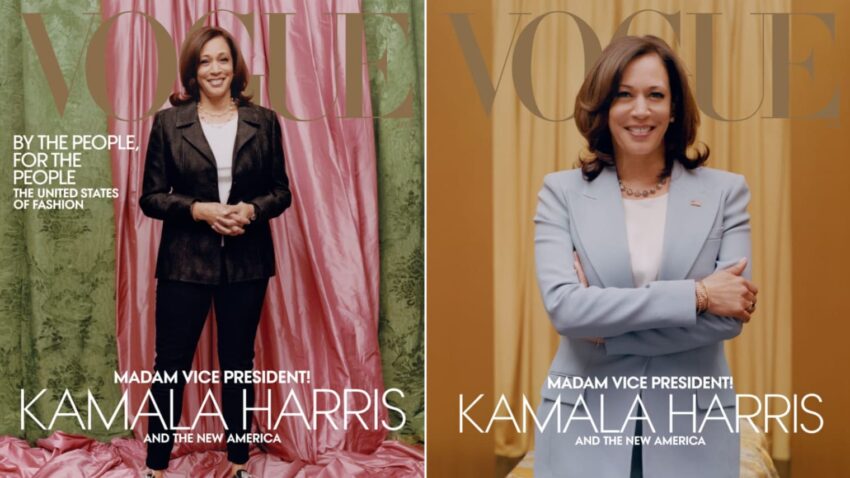
- “Vogue editor-in-chief Anna Wintour has broken her silence on the magazine’s February cover featuring Vice President-elect Kamala Harris,” Jacqui Palumbo reported Tuesday for CNN. “Critics took aim at the lighting and the styling, calling the image ‘washed out’ and asserting that the casual outfit was not appropriate for a historic magazine cover of the first woman and woman of color elected as Vice President of the United States. . . . In a statement to The New York Times, Wintour said that there was ‘no formal agreement’ about the cover choice, but emphasized that ‘it was absolutely not our intention to in any way diminish the importance of the Vice President-elect’s incredible victory.’ “
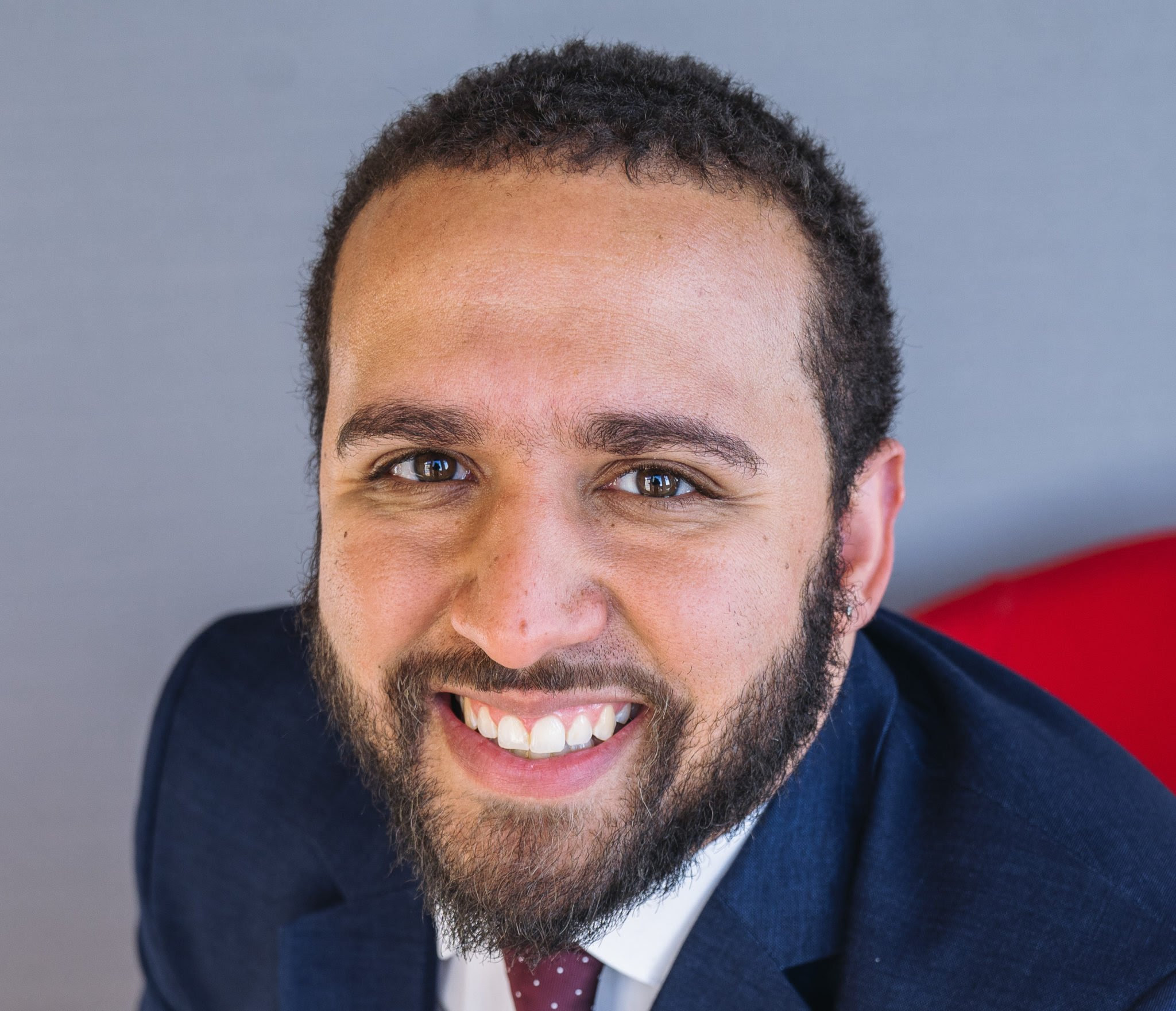 “Wesley Lowery (pictured) is joining The Marshall Project as a contributing editor,” the organization announced Tuesday. “He will spearhead a new initiative to develop original locally-reported investigative stories, continuing The Marshall Project’s expansion into local journalism . . . as well as serve as a mentor to Marshall Project reporters. Lowery, who is also a correspondent for CBS News, was previously a national correspondent at The Washington Post. . . .” The Marshall Project reports on the criminal justice system.
“Wesley Lowery (pictured) is joining The Marshall Project as a contributing editor,” the organization announced Tuesday. “He will spearhead a new initiative to develop original locally-reported investigative stories, continuing The Marshall Project’s expansion into local journalism . . . as well as serve as a mentor to Marshall Project reporters. Lowery, who is also a correspondent for CBS News, was previously a national correspondent at The Washington Post. . . .” The Marshall Project reports on the criminal justice system.
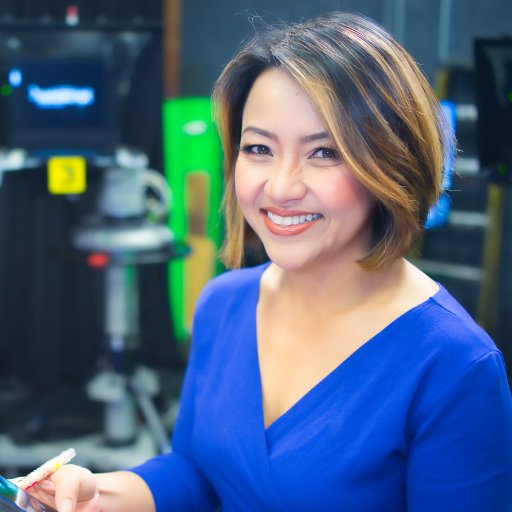 “In a rebuke from Congress, U.S. Representatives Gregory Meeks of New York and Michael McCaul of Texas chastised the heads of [U.S. Agency for Global Media] and Voice of America on Tuesday for reassigning a VOA White House correspondent,” Jessica Jerreat reported Tuesday for the Voice of America. “Patsy Widakuswara (pictured) was told late Monday she is being reassigned, hours after the veteran reporter attempted to question Secretary of State Mike Pompeo following a speech he delivered at VOA headquarters. . . . ” Twenty-six journalists have demanded that Voice of America’s director resign.
“In a rebuke from Congress, U.S. Representatives Gregory Meeks of New York and Michael McCaul of Texas chastised the heads of [U.S. Agency for Global Media] and Voice of America on Tuesday for reassigning a VOA White House correspondent,” Jessica Jerreat reported Tuesday for the Voice of America. “Patsy Widakuswara (pictured) was told late Monday she is being reassigned, hours after the veteran reporter attempted to question Secretary of State Mike Pompeo following a speech he delivered at VOA headquarters. . . . ” Twenty-six journalists have demanded that Voice of America’s director resign.
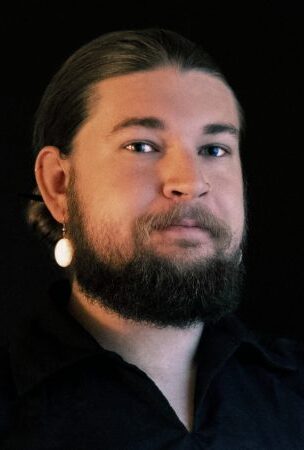 “Months after sending out a directive telling the editor of the student newspaper what he could and could not publish, the president of Haskell Indian Nations University has rescinded his memorandum,” Lauren Fox reported Thursday for the Lawrence (Kan.) Journal-World. “In an undated letter that just reached student journalist Jared Nally (pictured) on Wednesday, Haskell President Ronald Graham wrote that the university ‘took an incorrect approach’ in sending out the Oct. 16 directive.”
“Months after sending out a directive telling the editor of the student newspaper what he could and could not publish, the president of Haskell Indian Nations University has rescinded his memorandum,” Lauren Fox reported Thursday for the Lawrence (Kan.) Journal-World. “In an undated letter that just reached student journalist Jared Nally (pictured) on Wednesday, Haskell President Ronald Graham wrote that the university ‘took an incorrect approach’ in sending out the Oct. 16 directive.”
- “For the first time, the L.G.B.T. advocacy organization Glaad has found, more than half of L.G.B.T.Q. characters on prime-time scripted cable series were people of color (broadcast had already achieved that figure),” Sarah Bahr reported Thursday for The New York Times. “Streaming was the only platform in which white L.G.B.T.Q. characters (51 percent) outnumbered nonwhite ones.” Bahr also wrote, “For the first time in five years, L.G.B.T.Q. representation on television decreased, the report found. . . .”
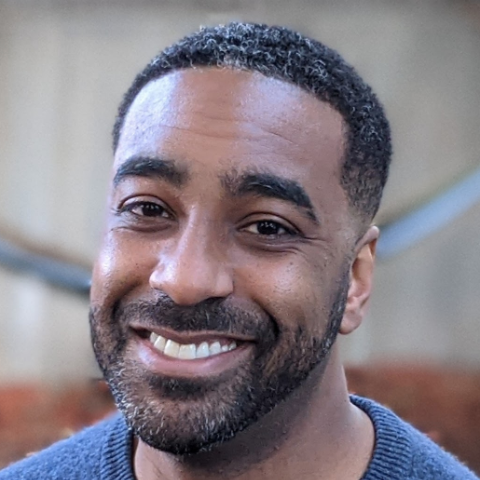 Matt Thompson (pictured) is joining The New York Times as editor of Headway, a new journalism initiative to investigate global and national challenges, The Times announced Jan. 8. “He will hire a team of journalists to cover a range of economic, social, health, infrastructural and environmental challenges.” Thompson is editor in chief of Reveal from the Center for Investigative Reporting. Prior to that, he was executive editor of The Atlantic; before that, he “led the creation of several teams of broadcast and digital journalists at NPR, including Code Switch and NPR Ed.”
Matt Thompson (pictured) is joining The New York Times as editor of Headway, a new journalism initiative to investigate global and national challenges, The Times announced Jan. 8. “He will hire a team of journalists to cover a range of economic, social, health, infrastructural and environmental challenges.” Thompson is editor in chief of Reveal from the Center for Investigative Reporting. Prior to that, he was executive editor of The Atlantic; before that, he “led the creation of several teams of broadcast and digital journalists at NPR, including Code Switch and NPR Ed.”
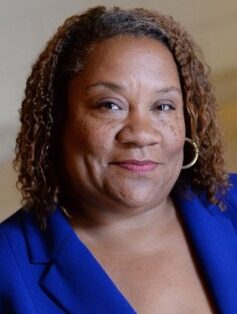 On Jan. 7, “Simon & Schuster announced that it would not publish The Tyranny of Big Tech, a book by Sen. Josh Hawley (R-MO) that was planned to come out in June,” as Constance Grady reported for vox.com on Monday. Dana Canedy (pictured), the first Black senior vice president and publisher at Simon Schuster, told Journal-isms last week, “This was entirely my decision, but with the support of our CEO,” Jonathan Karp. Grady added, “Hawley was the first senator to announce that he planned to object to [the June 6] congressional count of the presidential electoral votes, citing baseless claims of election fraud.”
On Jan. 7, “Simon & Schuster announced that it would not publish The Tyranny of Big Tech, a book by Sen. Josh Hawley (R-MO) that was planned to come out in June,” as Constance Grady reported for vox.com on Monday. Dana Canedy (pictured), the first Black senior vice president and publisher at Simon Schuster, told Journal-isms last week, “This was entirely my decision, but with the support of our CEO,” Jonathan Karp. Grady added, “Hawley was the first senator to announce that he planned to object to [the June 6] congressional count of the presidential electoral votes, citing baseless claims of election fraud.”
- Errin Haines, editor-at-large at The 19th, a nonprofit newsroom reporting on gender, politics and policy, has signed a two-book deal with Simon & Schuster, the website reported Friday. In the first book, tentatively titled “Twice As Good” and scheduled for publication early next year, “Haines will chronicle the rise of Black women in American politics as voters, organizers and candidates through the lens of the historic ascent of Vice President-elect Kamala Harris.” Publisher Dana Canedy messaged Journal-isms, “”We are so honored that Errin is joining the S&S family with this important book. We think Errin will be a huge house author for us with an important voice that we are thrilled to amplify.”,
- “Netflix Inc. has made gains in adding women and minorities to its workforce over the past three years, vaulting it past Silicon Valley peers, according to the entertainment company’s first-ever report on diversity and inclusion,” Lucas Shaw and Emily Chang reported Wednesday for Bloomberg. They also wrote, “Netflix also said that 8% of its employees at the end of 2020 were Black, more than double the share from the end of 2017. Hispanic employees climbed to 8.1% from 6%, the company said . . . . Netflix also has a higher percentage of Black and Hispanic employees than Google or Facebook. (Apple exceeds Netflix with its share of both Black and Hispanic employees.)”
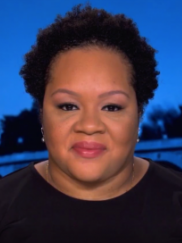 Yamiche Alcindor (pictured), White House correspondent for the “PBS NewsHour,” was “guest moderator” of PBS’ “Washington Week” for the second consecutive week Friday. Three of the four panelists were journalists of color: Geoff Bennett of CBS News, Seung Min Kim of The Washington Post and Pierre Thomas of ABC News. Peter Baker of The New York Times rounded out the commentators. After three years as host and managing editor, Robert Costa concluded his tenure on Jan. 1. “Costa is leaving television to co-write a book with renowned journalist Bob Woodward,” public station WNET-TV in New York reported Dec. 23.
Yamiche Alcindor (pictured), White House correspondent for the “PBS NewsHour,” was “guest moderator” of PBS’ “Washington Week” for the second consecutive week Friday. Three of the four panelists were journalists of color: Geoff Bennett of CBS News, Seung Min Kim of The Washington Post and Pierre Thomas of ABC News. Peter Baker of The New York Times rounded out the commentators. After three years as host and managing editor, Robert Costa concluded his tenure on Jan. 1. “Costa is leaving television to co-write a book with renowned journalist Bob Woodward,” public station WNET-TV in New York reported Dec. 23.
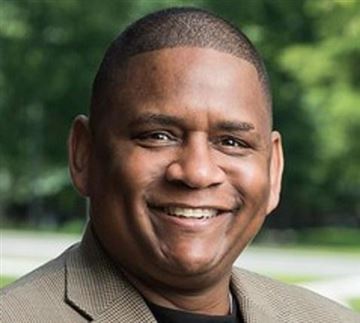 John Hollis, a former sports journalist for The Atlanta Journal-Constitution, learned in July that he fell into a rare category of people whose blood could help scientists understand Covid-19 and potentially treat those who fall ill, Curtis Bunn wrote Thursday for NBCBLK. Since August, Hollis, communications manager at George Mason University in Fairfax, Va., has given blood and saliva samples about every two weeks for lab testing and experiments. Dr. Lance Liotta, a George Mason pathologist and bioengineer who is leading the school’s clinical trials on antibodies, said that the levels of Hollis’ antibodies not only have sustained, but they they have also proved effective in killing six different strains of the coronavirus.
John Hollis, a former sports journalist for The Atlanta Journal-Constitution, learned in July that he fell into a rare category of people whose blood could help scientists understand Covid-19 and potentially treat those who fall ill, Curtis Bunn wrote Thursday for NBCBLK. Since August, Hollis, communications manager at George Mason University in Fairfax, Va., has given blood and saliva samples about every two weeks for lab testing and experiments. Dr. Lance Liotta, a George Mason pathologist and bioengineer who is leading the school’s clinical trials on antibodies, said that the levels of Hollis’ antibodies not only have sustained, but they they have also proved effective in killing six different strains of the coronavirus.
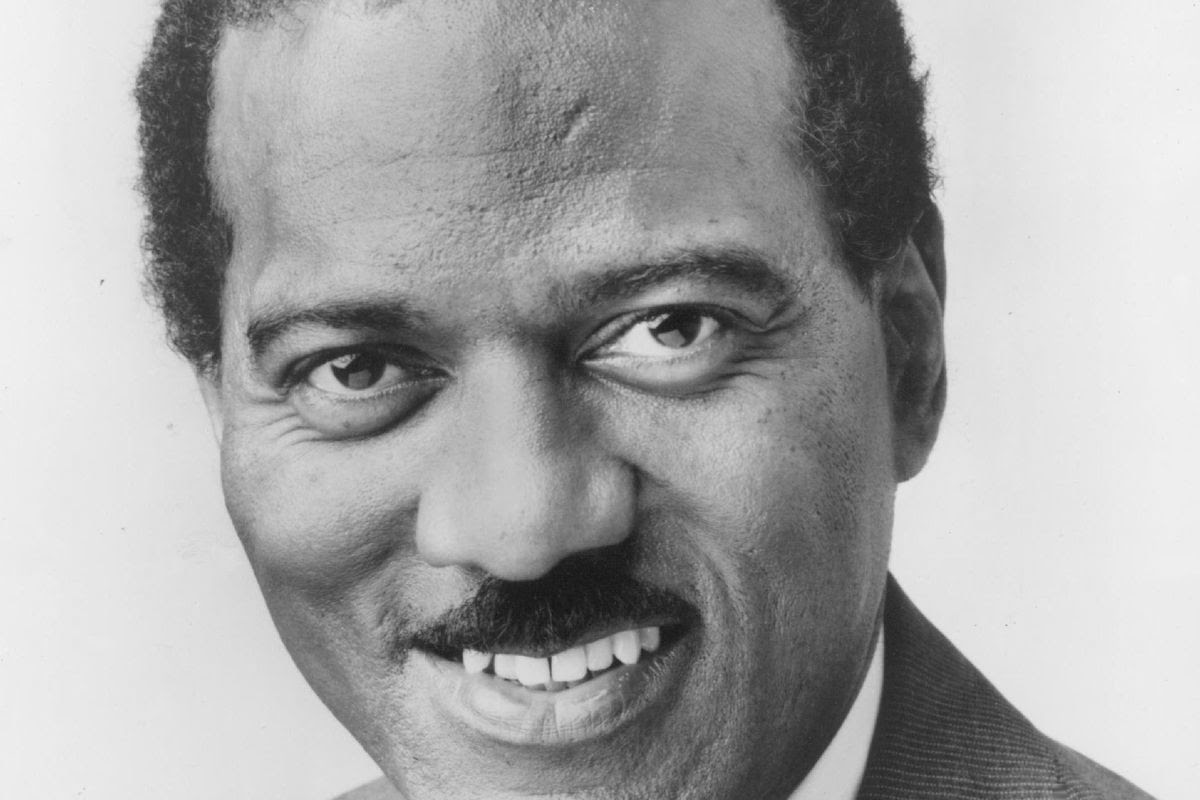 “Jim Tilmon (pictured), a trusted Chicago TV newsman, meteorologist and pioneering aviator, has died at 86 in Arizona, where he’d retired,” Maureen O’Donnell reported Saturday for the Chicago Sun-Times. “Mr. Tilmon died Saturday afternoon, according to Frank Whittaker, station manager of WMAQ-TV, where Mr. Tilmon worked for more than 22 years. The Emmy Award-winning broadcaster worked four more years at WTTW-TV. “Mr. Tilmon also was one of the nation’s first Black commercial airline pilots and the third African American pilot hired by American Airlines, for which he flew for 29 years. He did this in an era when some white passengers mistook his uniform for that of a skycap and tried to tip him to carry their luggage. . . .”
“Jim Tilmon (pictured), a trusted Chicago TV newsman, meteorologist and pioneering aviator, has died at 86 in Arizona, where he’d retired,” Maureen O’Donnell reported Saturday for the Chicago Sun-Times. “Mr. Tilmon died Saturday afternoon, according to Frank Whittaker, station manager of WMAQ-TV, where Mr. Tilmon worked for more than 22 years. The Emmy Award-winning broadcaster worked four more years at WTTW-TV. “Mr. Tilmon also was one of the nation’s first Black commercial airline pilots and the third African American pilot hired by American Airlines, for which he flew for 29 years. He did this in an era when some white passengers mistook his uniform for that of a skycap and tried to tip him to carry their luggage. . . .”
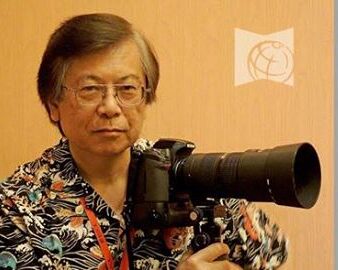 “Corky Lee (pictured), who’s dedicated his entire career to documenting the Asian American experience through photographs, is hospitalized and recovering from COVID-19,” Louis Chan reported Friday for AsAmNews. Chan also wrote, “Filmmaker and executive producer of the Heritage Series, Samantha Cheng, organized a Facebook campaign to [ensure] that Lee could get rest after leaving the hospital without worrying about going to work. In just a few days, it surpassed its $10,000 goal and raised more than $36,000. . . .”
“Corky Lee (pictured), who’s dedicated his entire career to documenting the Asian American experience through photographs, is hospitalized and recovering from COVID-19,” Louis Chan reported Friday for AsAmNews. Chan also wrote, “Filmmaker and executive producer of the Heritage Series, Samantha Cheng, organized a Facebook campaign to [ensure] that Lee could get rest after leaving the hospital without worrying about going to work. In just a few days, it surpassed its $10,000 goal and raised more than $36,000. . . .”
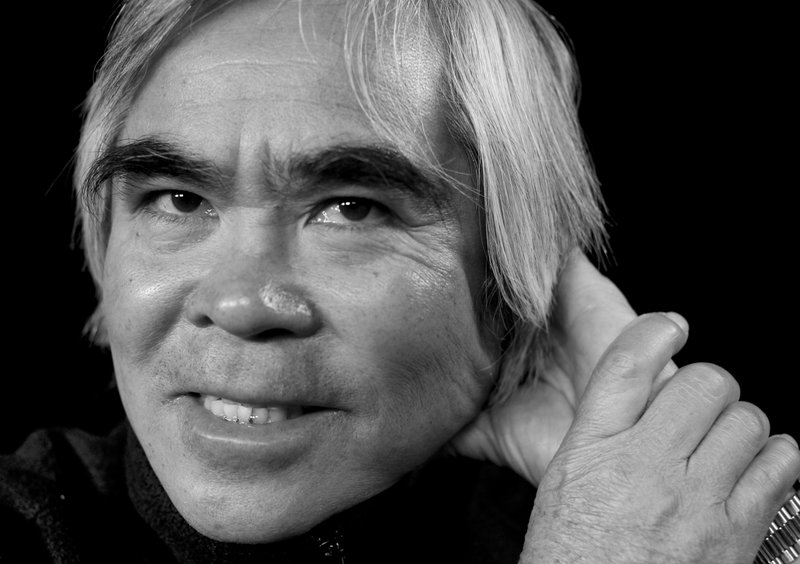 “Nick Ut (pictured)Thursday became the first journalist ever to receive the National Medal of Arts, but just hours later a person he described as a drug addict assaulted him,” Randall Yip reported Friday for AsAmNews. “ ‘Today my friend Mark Edward Harris go to have dinner with David Burnett. Outside White House we were attacked by drug addict young guy,’ he wrote on Instagram. ‘He knocked me down and hurt my ribs, back and left leg. Same leg I have metal in from mortar in Vietnam War. Maybe break my Leica (camera) too. Mark did martial art to defend me. Secret Service so fast to come over and help.’ ”
“Nick Ut (pictured)Thursday became the first journalist ever to receive the National Medal of Arts, but just hours later a person he described as a drug addict assaulted him,” Randall Yip reported Friday for AsAmNews. “ ‘Today my friend Mark Edward Harris go to have dinner with David Burnett. Outside White House we were attacked by drug addict young guy,’ he wrote on Instagram. ‘He knocked me down and hurt my ribs, back and left leg. Same leg I have metal in from mortar in Vietnam War. Maybe break my Leica (camera) too. Mark did martial art to defend me. Secret Service so fast to come over and help.’ ”
- In his newest documentary, MLK/FBI, which was scheduled to be available on demand Jan. 15, director Sam Pollard “(Mr. Soul!, Eyes on the Prize, Atlanta’s Missing and Murdered: The Lost Children) unveils the goals, weaponization and consequences” of FBI director J. Edgar Hoover’s racist obsession with the Rev. Martin Luther King Jr.,” Soraya Nadia McDonald wrote Friday for The Undefeated. “Pollard tackles, with grace and generosity, the most uncomfortable and morally thorny areas of King’s life and how they came to light. . . .”

- “Punchbowl, which sent its first dispatch on Sunday night, is the latest news outlet to be started by veterans of Politico, the organization founded in 2007 to cover politics with the speed of the internet and the glee of ‘SportsCenter,’ ” Ben Smith wrote Jan. 3 for The New York Times. It “promises a scoop-driven, just-the-facts-ma’am operation founded by three defectors from the Washington publication Politico,” Jake Sherman, Anna Palmer and John Bresnahan. Asked about the absence of journalists of color, Palmer messaged Journal-isms Monday, “Diversity is a priority for us as we look to grow the team past the initial founders. We are also ensuring diversity is a priority when determining who we contract work to (e.g. web developers, design, etc.).”
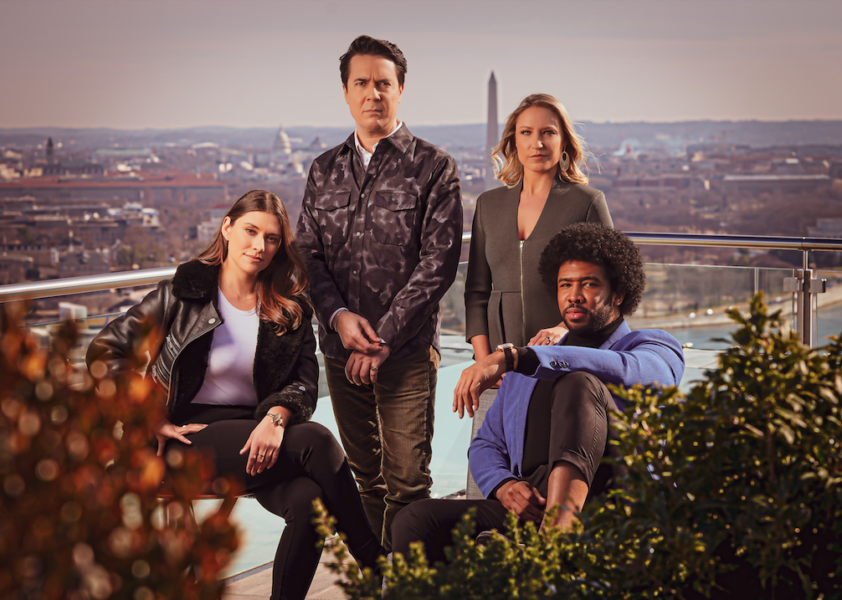
- “POLITICO today announced a new Playbook team that will helm the indispensable, but unofficial, guide to official Washington,” Melissa Cooke wrote Friday for Politico. “On January 19, Rachael Bade, Eugene Daniels, Ryan Lizza and Tara Palmeri take the reins of POLITICO Playbook to set the agenda for the political day and days ahead; break news and make sense of it; and provide a steady dose of insider nuggets and intrigue for and about the power players in Washington.” . . . Daniels is “a White House Reporter and Playbook Author covering Vice President Kamala Harris, First Lady Dr. Jill Biden and the Second Gentleman. . . .”
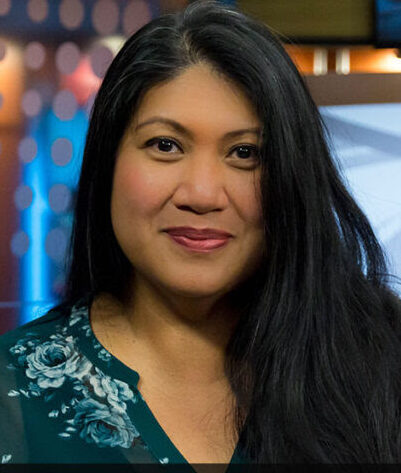 “Jeimmie Nevalga (pictured), a veteran TV producer, has been named news director for KOMU-TV in Columbia, Missouri, effective Feb. 1,” the Missouri School of Journalism announced Jan. 5. “KOMU 8 is the only network affiliated commercially operated television station (NBC) whose newsroom is utilized as a teaching lab. Students at the Missouri School of Journalism cover mid Missouri under the supervision of faculty. . . . The appointment makes Nevalga the first woman and minority to lead the news department at KOMU.”
“Jeimmie Nevalga (pictured), a veteran TV producer, has been named news director for KOMU-TV in Columbia, Missouri, effective Feb. 1,” the Missouri School of Journalism announced Jan. 5. “KOMU 8 is the only network affiliated commercially operated television station (NBC) whose newsroom is utilized as a teaching lab. Students at the Missouri School of Journalism cover mid Missouri under the supervision of faculty. . . . The appointment makes Nevalga the first woman and minority to lead the news department at KOMU.”
- “The Navajo Times, based in Window Rock, Arizona, is the only newspaper focussed on reporting the news of the Navajo Nation — which covers an area larger than West Virginia and is home to more than a hundred and seventy thousand people,” Andrea DenHoed wrote Thursday for the New Yorker. “Many residents of the reservation don’t have Internet service, so the paper is vital to the community in a way that is increasingly rare these days, as local-news outlets around the nation are withering, sometimes supplanted by social media and sometimes by nothing at all. Eléonore (Léo) Hamelin’s short documentary ‘The People’s Newspaper’ follows staff members of the Navajo Times as they travel across the reservation collecting stories and covering the COVID-19 outbreak. For most of last year, the per-capita coronavirus-infection rate on the reservation was the highest in the country. . . .”
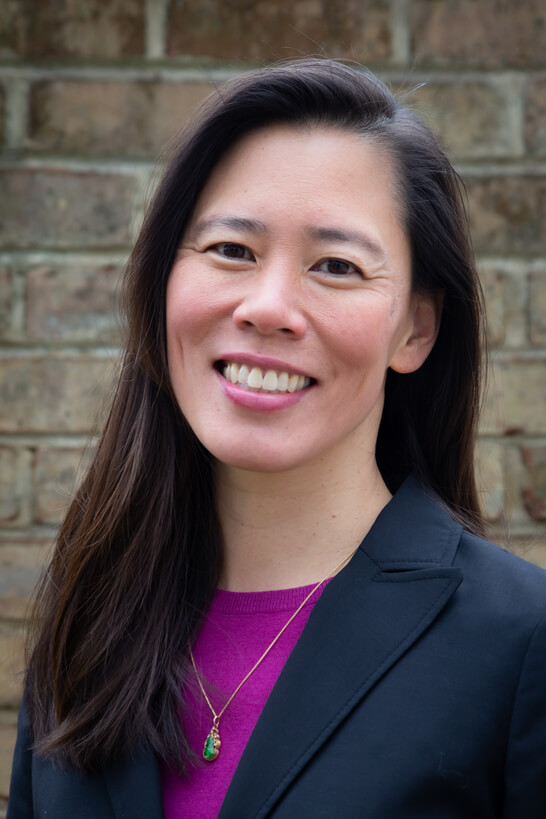 Howard University has named Rin-rin Yu (pictured) as editor-in-chief. Her responsibilities will include producing Howard Magazine and leading the University’s storytelling efforts and strategy through other key channels, the school announced on Monday. It also said, “For the past five years, she managed Silver Media Group, a strategic communications consultancy that she co-founded. She began her journalism career in TV news at ABC News in New York.”
Howard University has named Rin-rin Yu (pictured) as editor-in-chief. Her responsibilities will include producing Howard Magazine and leading the University’s storytelling efforts and strategy through other key channels, the school announced on Monday. It also said, “For the past five years, she managed Silver Media Group, a strategic communications consultancy that she co-founded. She began her journalism career in TV news at ABC News in New York.”
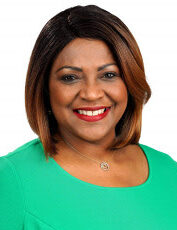 In Indianapolis, “Investigative reporter Sandra Chapman (pictured), is leaving WTHR-TV Channel 13 after 17 years at the station and 34 years in local news,” the Indianapolis Business Journal reported Thursday. “Chapman announced the news on Twitter on Thursday afternoon, saying that it’s ‘now my choice to pursue other dreams and goals.’ The station announced the change during the evening news.”
In Indianapolis, “Investigative reporter Sandra Chapman (pictured), is leaving WTHR-TV Channel 13 after 17 years at the station and 34 years in local news,” the Indianapolis Business Journal reported Thursday. “Chapman announced the news on Twitter on Thursday afternoon, saying that it’s ‘now my choice to pursue other dreams and goals.’ The station announced the change during the evening news.”
- “Irish people are concerned about the lack of diversity in Irish media while they are also worried about the proliferation of opinion-based journalism that has taken root in many media organisations, according to the latest Core Predict 2021 research,” Adworld, the online information portal of Irish Marketing Journal, reported Friday. “According to the report: ‘Young people remain very conscious about the lack of diversity in Irish media. 16% of adults say ‘TV shows and news coverage having greater diversity of people (e.g. more people of colour)’ is important, with a further 47% of people saying it is somewhat important. Urban 18-24 year olds are more likely to say the need for diversity is very important to them.”
- ” Ugandan opposition leader Bobi Wine’s party said on Sunday that it was preparing to challenge President Yoweri Museveni’s election win and condemned what it called the house arrest of Wine, as news emerged of two people killed in protests over the result, Reuters reported. Victor Bwire wrote Sunday of the election for the Star in Kenya, “Journalists were threatened, assaulted, trolled, media houses closed down or banned, sources hounded out of studios while in the extreme editorial content was sacrificed on the alter of political advertising.”
- In Trinidad, “A police raid on a media house in March last year has been deemed unconstitutional by the court,” the Jamaica Gleaner reported Wednesday. “Justice Frank Seepersad held on Wednesday that the two search warrants obtained by the police for the Trinidad Express newspaper in search of information which could lead them to a journalist’s source were ‘plainly irregular’, unlawful, and unconstitutional as they disproportionally infringed on the media house’s right to freedom of the press.”
- “The International Press Institute (IPI), a global network of editors, media executives and leading journalists for press freedom, today vehemently condemned a third cyber libel case against Philippine editor Maria Ressa and urged that it be dropped immediately,” the organization said Friday. “The latest charge together with an arrest warrant were issued against Ressa, the founder of news portal Rappler and a member of IPI’s Executive Board, and reporter Rambo Talabong on January 11. The arrest was filed in response to an investigative story about an alleged corruption scheme at a private Philippine college. . . .”
- “CNN a few days ago again ruffled [Kenyans’] feathers with a story on its website, ‘The Woman who found whales in Kenya,’ ” Charles Onyango-Obbo wrote Tuesday for The East African in Kenya. “The story told of Jane Spilsbury, a former lawyer in London, who moved to the Kenyan coastal of Watamu some years ago to join her husband, and heard stories from local fishermen of whales and dolphins in the ocean, and decided to go out to photograph them. Turns out they were humpback whales, and the people in the area had known about them for more than 30 years.”
- “Were it not for the notoriety of Western media’s often reductionist reporting of the Global South, I would be confounded by the New York Times article published on 4 January entitled ‘A Continent Where the Dead Are Not Counted’,” Mamka Anyona wrote Jan. 8 for African Arguments. “Bylined from Lagos, its central thesis is that the low death rates from COVID-19 in ‘Africa’ are because Africans do not report deaths. It suggests that the actual death rate in countries on the continent could be anywhere from the publicly reported rates to the kinds of high rates reported in Europe and the Americas. What this implies is that death is so commonplace in ‘Africa’ that if about 1 in every 1,000 people – the current reported death rate from COVID-19 in the US – died from a previously unknown illness in a matter of months, it could go unnoticed and unrecorded. The article’s premise is astounding. . . .”
To subscribe at no cost, please send an email to journal-isms+subscribe@groups.io and say who you are.
Facebook users: “Like” “Richard Prince’s Journal-isms” on Facebook.
Follow Richard Prince on Twitter @princeeditor
Richard Prince’s Journal-isms originates from Washington. It began in print before most of us knew what the internet was, and it would like to be referred to as a “column.” Any views expressed in the column are those of the person or organization quoted and not those of any other entity. Send tips, comments and concerns to Richard Prince at journal-isms+owner@
View previous columns (after Feb. 13, 2016).
View previous columns (before Feb. 13, 2016)
- Diversity’s Greatest Hits, 2018 (Jan. 4, 2019)
- Book Notes: Is Taking a Knee Really All That? (Dec. 20, 2018)
- Book Notes: Challenging ’45’ and Proudly Telling the Story (Dec. 18, 2018)
- Book Notes: Get Down With the Legends! (Dec. 11, 2018)
- Journalist Richard Prince w/Joe Madison (Sirius XM, April 18, 2018) (podcast)
- Richard Prince (journalist) (Wikipedia entry)
- February 2018 Podcast: Richard “Dick” Prince on the need for newsroom diversity (Gabriel Greschler, Student Press Law Center, Feb. 26, 2018)
- Diversity’s Greatest Hits, 2017 — Where Will They Take Us in the Year Ahead?
- Book Notes: Best Sellers, Uncovered Treasures, Overlooked History (Dec. 19, 2017)
- An advocate for diversity in the media is still pressing for representation, (Courtland Milloy, Washington Post, Nov. 28, 2017)
- Morgan Global Journalism Review: Journal-isms Journeys On (Aug. 31, 2017)
- Diversity’s Greatest Hits, 2016
- Book Notes: 16 Writers Dish About ‘Chelle,’ the First Lady
- Book Notes: From Coretta to Barack, and in Search of the Godfather
- Journal-isms’ Richard Prince Wants Your Ideas (FishbowlDC, Feb. 26, 2016)
- “JOURNAL-ISMS” IS LATEST TO BEAR BRUNT OF INDUSTRY’S ECONOMIC WOES (Feb. 19, 2016)
- Richard Prince with Charlayne Hunter-Gault,“PBS NewsHour,” “What stagnant diversity means for America’s newsrooms” (Dec. 15, 2015)
- Book Notes: Journalists Follow Their Passions
- Book Notes: Journalists Who Rocked Their World
- Book Notes: Hands Up! Read This!
- Book Notes: New Cosby Bio Looks Like a Best-Seller
- Journo-diversity advocate turns attention to Ezra Klein project (Erik Wemple, Washington Post, March 5, 2014)
